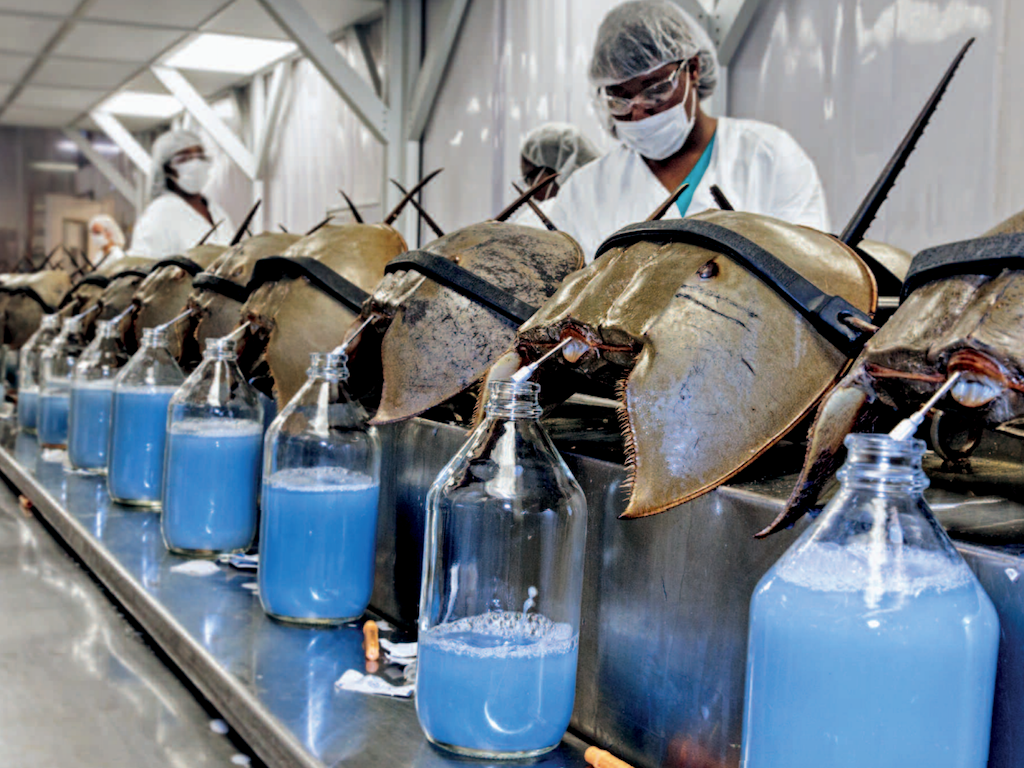This utilises the coagulative properties of Atlantic horseshoe crab Limulus polyphemus blood to detect endotoxins linking this immunologically unique and ancient species to the global supply chains of modern health and medicine. Their blood is blue because they use copper as a carrier for oxygen while humans use iron as a carrier of oxygen in their red blood.
Crab blood amebocytes can coagulate around as little as one part in a trillion of bacteria the equivalent of a grain of sand in a pool and the reaction takes less than an hour in contrast to more than two days for mammal blood.

Horseshoe crab blood uses. Horseshoe crab blood ensures that there are no dangerous bacteria in newly created drugs. In other words horseshoe crab blood can detect the presence of toxins. Their blood is hyper-sensitive to dangerous bacteria and traps it.
Hundreds of thousands of horseshoe crabs Limulus polyphemus are bled each year to produce a substance called Limulus Amebocyte Lysate LAL. Standard practice is to remove 30 of the crabs blood and then return them to the water but 30 of these crabs never make it through the process. The price of horseshoe crab blood is also unbelievably high at 15000 per quart making it an expensive resource.
National Geographic says that the animals milky-blue blood provides the only known natural source of. As a result the blood is used to ensure medical equipment and other tools are in fact sterile. While many animals have similar blood mechanisms for keeping out intruders few do it as well as the horseshoe crab.
Instead of white blood cells to fight infection many invertebrates have amebocytes and Atlantic horseshoe crabs Limulus polyphemus have evolved these to such a peak of refinement that they are. LAL is used to test intravenous drugs and medical equipment for the presence of bacteria and endotoxin a poison found in many bacteria. And horseshoe crab blood is the only thing humans can find anywhere.
A protein in the blood called Limulus Amebocyte Lysate LAL is used by pharmaceutical and medical device manufacturers to test their products for the presence of endotoxins bacterial substances that can cause fevers and even be fatal. An extract in the crabs blood cells chemically reacts to harmful stuff and scientists use it to test if new medicines are safe. The current global health crisis.
Horseshoe crab blood is an essential element in testing the safety of new drugs and vaccines. Because of this these crabs may have an important role to play in vaccine development. Horseshoe crabs blue blood is harvested by the biomedical industry for testing of drugs and medical devices.
The horseshoe crabs blue blood is used to detect toxins in the medicine. What is horseshoe crab blood used for. So what are horseshoe crab blood uses.
There is also no efforts made by labs to ensure the survival of the crabs that do make it back into the water. It contains important immune cells that are exceptionally sensitive to toxic bacteria. Horseshoe crab blood and rFC are both used to screen injectable drugs for the presence of toxic contamination.
When those cells meet invading bacteria they clot around it and protect the rest of the horseshoe crabs body from toxins. The medical industry uses 600000 horseshoe crabs for their blood every year. Safety tests using horseshoe crab blood is currently the industry standard.
Horseshoe crab blood is bright blue. The blood of the horseshoe crab provides a valuable medical product critical to maintaining the safety of many drugs and devices used in medical care. The crabs unique blood chemistry leads to unmistakably clear reactions to.
The crabs blood clots around the bacteria and then. Its the blood of the horseshoe crab a water arthropod found on the eastern shores of North America and Asia. For example horseshoe crab blood is used to check the safety of pharmaceuticals vaccines prosthetics and other tools used in the medical field.
The Short Answer.



